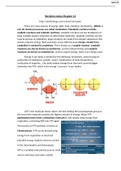Joel Y13
Revision notes Chapter 12
http://astarbiology.com/a-level/cie/notes/
There are many sources of energy; light, heat, chemical, mechanical... Within a
cell, all chemical processes are called metabolism. Metabolic reactions include
anabolic reactions and catabolic reactions; catabolic reactions are the breakdown of
large complex organic molecules to yield simple molecules. Anabolic reactions are the
reverse process of catabolism, larger products are made from simpler substances, this
process requires energy. Both processes occur often because energy created from
catabolism is needed for anabolism. This is known as a coupled reaction. Catabolic
reactions can also be known as exothermic, as they release energy and anabolic
reactions are known as endothermic, as they require energy, there is an energy input.
Energy in our body is needed for the following; movement, active transport,
production of substances, growth, repair, maintenance of body temperature,
conduction of impulses... Our body obtains energy from food and converts bigger
molecules into ATP, which is the energy “currency” in our bodies.
ATP is the molecule shown above, the link holding the last phosphate group to
the rest of the molecule contains the highest amount of energy. When ATP
dephosphorylates (loses a phosphate molecule) it will rebuild using energy from
respiration, converting ADP into ATP again.
The process of ATP synthesis is known as
Chemiosmosis. ATP can be formed using
energy from respiration or electrical
potential energy made by electron carriers
in the mitochondria and chloroplasts.
ATP is a suitable molecule because its small,
easy to hydrolyze and water soluble.
, In this diagram, chemiosmosis is shown. The
proton pump is used to keep a higher
concentration of protons (hydrogen ions)
outside of the mitochondrial membrane,
therefore, the H+ ions are able to enter the
membrane through the ATP synthase protein to
be able to produce ATP from ADP.
ATP plays a vital role in active transport. Active transport is the movement of
molecules or ions across a partially permeable membrane against a concentration
gradient. ATP is needed to move substances against their concentration gradients. The
sodium-potassium pump is a protein that has binding sites for sodium and for ATP on
the inner side and for potassium on the outer side. It acts as an ATPase and hydrolyses
ATP into ADP releasing energy for the pump to function. Potassium is needed inside of
the cell and sodium needs to be release outside against their concentration gradients,
due to the use of a pump and energy from ATP hydrolysis this process is possible. For
every ATP used, two potassium ions move into the cell and three sodium ions are
moved outside from the cell. About 50% of used by resting mammals is used to
maintain ionic contents.
Respiration is the process in which organic molecules act as fuel. Organic
molecules are broken down in a series of stages to release chemical potential energy,
which is used to synthesize ATP. The main fuel in cells are carbohydrates, commonly
glucose. Fatty acids, glycerol and amino acids can also be broken down less commonly.
Glucose breakdown can be divided into four stages: glycolysis, links reaction,
the Krebs cycle and oxidative phosphorylation.
Glycolysis
It is the first stage in respiration. It takes place in the cytoplasm and it begins
when a glucose molecule (or another hexose sugar) is phosphorylated into two, ATP
molecules donate a phosphate to it. This will produce hexose biphosphate, which will
split into two triose phosphate molecules. Each triose phosphate is converted into a
pyruvate molecule by removing hydrogens. These hydrogens are taken up by the
coenzyme NAD, this process is an oxidation reaction or also known as
dehydrogenation. This will produce reduced NAD. At the end of the process, the
phosphate groups from the triose phosphates are added to ADP to produce four ATP
molecules. As two ATP molecules are used at the beginning of the process and four are






